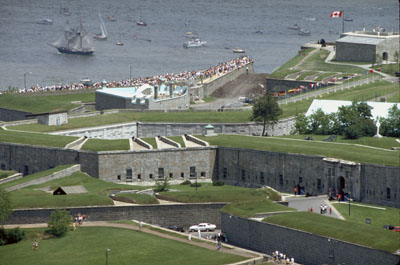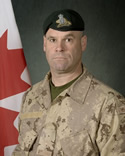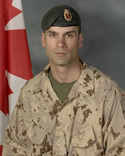
The Royal 22e Régiment (R22eR), whose headquarters are at the Citadelle de Québec, is one of the three infantry regiments of the Canadian Regular Force. It is a francophone regiment made up of five battalions, of which three belong to the Regular Force and two to the Reserve Force.

Québec Citadel
In the 1870s, Governor General Lord Dufferin persuaded the city not to demolish the fortifications, thus defining the historic character - and tourist potential - of old Québec (courtesy National Defence).
The Royal 22e Régiment (R22eR), whose headquarters are at theCitadelle de Québec, is one of the three infantry regiments of the Canadian Regular Force. It is a francophone regiment made up of five battalions, of which three belong to the Regular Force and two to theReserve Force. In 2014, the R22eR will celebrate its 100th anniversary.
The regiment has participated in all of Canada’s major military engagements since the First World War, including the United Nations peace missions and the campaign in Afghanistan.
Laval (4th) and Saint-Hyacinthe (6th).
In an environment where the primary language of work is French, soldiers of the R22eR are volunteers who perform tasks suited to this type of unit: garrison operations, peacekeeping and peacebuilding, combat operations, etc. The battalions of the R22eR may therefore be called into action at any time and in various locations around the world to carry out Government of Canada missions requiring a military presence.
The R22eR also plays an important role in Canadian heritage. It is the most significant regiment in Québec in terms of numbers and also the best organized in operational terms. Thousands of Québécois have served in its ranks since its inception in 1914, in combat operations as well as on peacekeeping and peacebuilding missions.
Georges Vanier, was the driving force behind the change.
When the Second World War broke out in September 1939, the R22eR was mobilized and sailed to England at the end of the year. The regiment spent nearly the entire conflict on the Italian front. It disembarked in Sicily in July 1943 and withdrew from northern Italy in February 1945. From March to May 1945, the regiment was part of the Canadian Army, which was fighting in Holland and Germany at the time.
With the Korean War, the R22eR increased in size from one to three battalions. These battalions took turns serving on the Korean peninsula between 1951 and 1953.
In the decades that have followed, the regiment has carried out peacekeeping and peacebuilding missions for the United Nations. The most significant of these include Cyprus from 1964 to 1992, a number of missions in the Former Yugoslavia (from 1992 to 2001 under the UN and NATO), and Haiti in the mid-1990s. An entire battalion was also sent to Haiti in 2010 after the earthquake. In 2007, members of a number of units from the 3rd Battalion of the R22eR were deployed to Afghanistan as part of NATO’s International Security Assistance Force in the Kandahar region. In 2009, members of the 2ndBattalion of the R22eR served in the same region. Troops belonging to the 1st Battalion carried out a similar mission in 2010, while other members have been training the Afghan police and army since 2011.
The Tangible and Intangible Heritage of the Régiment
There are many symbols that have made the R22eR what is has been since 1914. The regiment’s most precious symbol is its flag, which represents its body and soul and attests to the pride and honour associated with military service. Many emblems were adopted during the First World War.
The R22eR monument located at Place George-V in the city of Québec illustrates the strength of regimental tradition in the area and promotes military heritage outside military institutions as such. Inaugurated in 1989, it lists the names of soldiers who lost their lives in the line of duty.
The regiment can also be recognized by its insignia, which depicts a beaver inscribed with “22,” “Régiment canadien-français” and the regimental motto “Je me souviens.” Appearing on the flag, hats, and all other objects of regimental life, the beaver is yet another symbol by which the general public and other Canadian and foreign military forces can identify the regiment.
The specific symbols and traditions of the R22eR are displayed in detail at the museum of the Royal 22e Régiment, which has been located at the Citadelle de Québec since it was founded in 1950. The regimental museum plays a significant role in spreading knowledge and making the public aware of military traditions.
A number of local, provincial, national and international activities have been planned for the 100th anniversary of the founding of the R22eR in 2014. Each activity will illustrate the rich past of this regiment, embodying as it does the integration and active participation of francophones in the Canadian Forces.
The Royal 22e Régiment - The Canadian Encyclopedia
-
A note on the name
Most units of the Canadian Forces have official names in English and in French, but the historic regiments are exceptions, having monolingual names for the sake of tradition. The English name "Royal 22nd Regiment" is often seen, but strictly speaking is incorrect: only the French form is official.
-
The recent Fallen Van Doos heroes :
Simon Longtin

Mario Mercier

Christian Duchesne

-
Some recent videos of the regiment
